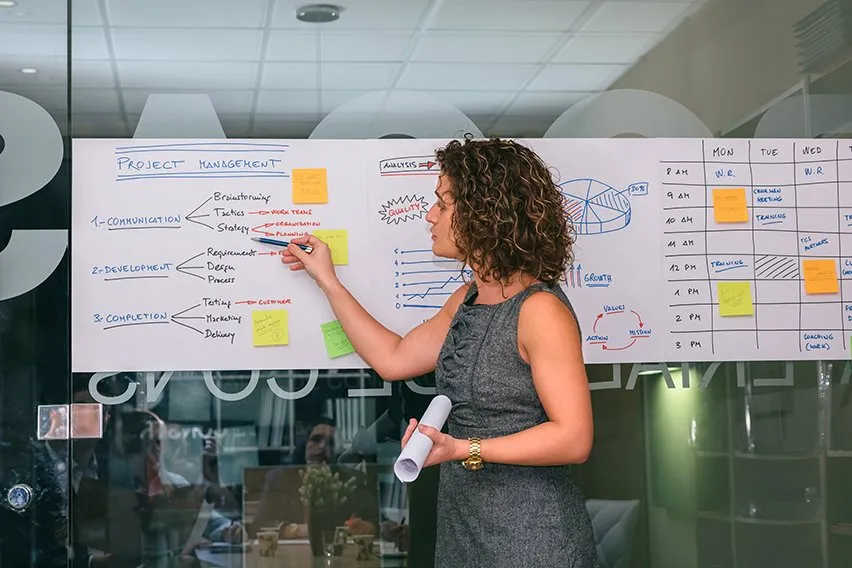Matrix Organisational Structure: Definition, Pros & Cons

A matrix organisational structure refers to a company structure in which teams have multiple leaders. A team member reports to a project manager, functional manager, and head of the department.
This system allows for open communication between teams. It also helps companies develop better services and products.
In this article, you’ll learn to better understand these structures and how they work. Keep reading to discover everything you need to know about matrix organisational structures.
Table of Contents
What Is a Matrix Organisational Structure?
Matrix Organisational Structure: How Does It Work?
Matrix Organisational Structure Types
Pros of a Matrix Organisational Structure
Cons of a Matrix Organisational Structure
Matrix Organisational Structure Examples
Enhance Matrix Structure Using Project Management Tools
What Is a Matrix Organisational Structure?
A matrix organisation structure consists of team members reporting to various department leaders. These team members can work from home or in-house. They report to a project manager, functional manager, and department head.
With a matrix organisational structure, companies can create new, successful products and services. And they can do so without having to realign teams.

Matrix Organisational Structure: How Does It Work?
A matrix organisation has at least 2 management reporting structures. That means that a team member reports to at least 2 bosses or chains of command.
A matrix structure is slightly different from a typical work structure. In a matrix, team participants report to project managers. A single project may call for work from different department managers and department heads, like marketing, IT, or finance. That’s why having a separate manager for every project makes sense.
Matrix Organisational Structure Types
There are 3 types of matrix structures. Each type assigns the project manager with more or less authority. These types include a weak matrix, a strong matrix, and a balanced matrix.
Weak Matrix
Here, a project manager participates little in decision-making compared to other matrix structures. In this case, with the manager’s limited authority, the matrix can become weak. Issues occur because the project timeline and budget are the department head’s responsibility.
Strong Matrix
A strong matrix means that the project manager has most of the power in decision-making. The department head, on the other hand, has more limited powers.
In such a situation, you get a stronger organisational structure. When the project manager is fully in charge of the project, the department manager only oversees the process. They do not contribute to any key decisions.
Balanced Matrix
A balanced matrix means that the project manager and department head share equal authority. Team members working on the project report to both of them. Communication is open between different leadership roles. And everyone can contribute to the project’s development.
Pros of a Matrix Organisational Structure
The matrix structure is more complex than a hierarchical structure. And it has numerous advantages. These include:
Clear Project Objectives
With matrix organisation design, you get more clarity on objectives. As the team reports their progress to the department head and project manager, it’s important to solidify the project’s goals.
It’s important for the project manager to feel support from other senior management members. In this case, the organisation of the project becomes more important.
The GM, COO, CFO, and Human Resources Department can all stay hands-off. (But they can intervene if called upon by the development team or either chain of command.)
Efficient Resource Usage
Want more efficient use of resources? Have specialists from different departments work on a project together. The overhead costs are lower, and the time needed for project completion goes down. This approach will benefit projects.
It’s easy to understand this benefit if we compare the matrix to a hierarchical structure organisation. In the latter, teams need more time to make a project deliverable. That’s because they only report to a single manager. They also lack members with different specialties.
A matrix team also lowers the cost of a project. Thanks to the combined group of experts, companies don’t have to restructure teams. And they don’t have to bring in new members whenever they develop a new service or product.
Free-Flowing Information
A matrix structure supports the free flow of information among teams. Team members can report to the functional manager, project manager, and head of the department.
You may find it time-consuming to report information to everyone in a matrix organisation. However, reporting becomes much easier when you implement a proper project management system.
Training for Project Managers
The matrix structure offers project managers plenty of responsibility. These people need to lead teams throughout the project lifecycle. Managers of such teams can become cross-functional throughout different departments.
Team Retention
A team is more likely to stay together and succeed when it’s made of specialists. The team members work in functional departments with functional managers. And they often love working together.
As a result, project performance improves. Plus you will see more projects delivered on time.
Cons of a Matrix Organisational Structure
Even though the matrix organisational structure has many benefits, it’s still not perfect. Here are the downsides:
Complex Reporting Style
Matrix management can get complicated. Teams do not always understand to whom and when they should report. Even though the purpose of the matrix is to help teams communicate better, the system can also be confusing for project team members.
But there’s an easy fix. You have to make sure every team member in complex projects knows to whom they should report. Accessible project management platforms can assist in the process.
Slow Response Time
The structure’s complexity makes it harder for team members to understand who they’re reporting to. This difficulty can also impact the project deadline. And while it’s almost always good when more people work on a project, communicating among project teams can take more time.
Again, a robust project management system can help with slow response times.
Guidance Issues
Sometimes, the department lead and the project manager may not be on the same page. Although the matrix structure promotes teamwork, it can also lead to poor results.
There should be a strict system that lets managers directly interact with each other. You don’t want team members to ever get caught in the middle between 2 bosses.
Risk of Friction
Reporting to separate managers in the matrix structure can make a business more complex. Team members must bear more responsibility. As a result, having 2 managers can cause friction. This worsens with multiple projects, some of which may cause conflict.
The best way to avoid friction is to ensure proper communication between the head of the department and the project manager.
Matrix Organisational Structure Examples
The Dutch company Philips started using this structure in 1970. Managers reported to the production head and geographical managers.
The approach became so popular that other organisations adopted it. This includes the likes of Hughes Aircraft, General Motors, and Caterpillar Tractors. There are many tales online of businesses that found success with matrix organisation structures.
Now, let’s look at an imaginary example of the matrix structure. Say you work for an advertising agency’s media development team. In fact, you’re a content writer.
In a matrix approach, you’d report to the manager of the media department. You’d also report to the functional manager or the head of your department.
And you’d have to report to the project manager in charge of your specific project. The functional manager would take care of the technical aspects of their own department. The project manager tracks the performance of the product team.
Enhance Matrix Structure Using Project Management Tools
Using tools to aid in project management can help boost the matrix structure of an organisation. With such tools, heads of departments and project managers can set clear goals. They can also develop a clear communication channel and plan to work together.
When all pieces of project management are in place, team members gain clarity. They’ll know how to achieve their project objectives and work more efficiently.
Looking for easy collaboration solutions for your small business? We suggest using FreshBooks’s project management software. It lets you invite employees, contractors, or business partners to take part in project management.
You can give team permissions to every person and decide which files they can access. With FreshBooks, you get a single, centralised, web-based place for storing files. You also get project planning features, profitability tools, tracking tools, and much more.
Key Takeaways
The matrix structure makes communication easier between everyone. It links team members, a functional manager, a project manager, and a department head together. Every member of the reporting line can communicate with their superiors throughout the project.
In the meantime, the primary manager or CEO can focus on growing the business. And they can choose to only involve themselves in project-related issues when necessary.
Team project managers can take part more in the decision-making process. And they can climb the corporate ladder further.
The best way to install the matrix structure is to use a dedicated project management system. Software such as FreshBooks is easy to use. And it’s fantastic for managing all sorts of projects.
FAQs on Matrix Organisational Structure
What Company Has a Matrix Organisational Structure?
There are many examples of companies that use this structure. These include Caterpillar, Philips, Texas Instruments, Nike, Starbucks, and many more.
What Is a Matrix Management System?
A matrix management system is an organisational structure where employees report to more than one boss. The teams are collaborative, and team members come from different units. Team members report to their functional manager and a team leader.
What Is the Difference Between a Functional and Matrix Organisational Structure?
A functional structure divides an organisation based on its functional areas. (These include marketing, production, or sales.) The matrix structure groups employees concurrently by 2 operational dimensions, most often consisting of a divisional and functional structure.
Are Matrix Organisations Effective?
A matrix organisation can drastically improve the quality of a business. It makes the business decision-making process more functional. And it brings needed information to the table.
RELATED ARTICLES


 Risk Register: What It Is and How to Create One
Risk Register: What It Is and How to Create One What Are Profitability Ratios? Definition, Types & Importance
What Are Profitability Ratios? Definition, Types & Importance What Is Compensation Management? Definition & Importance
What Is Compensation Management? Definition & Importance 8 Reasons Why Is Collaboration Important in the Workplace?
8 Reasons Why Is Collaboration Important in the Workplace? Product Manager Vs Project Manager: What’s the Difference
Product Manager Vs Project Manager: What’s the Difference 5 Best Job Costing Software: Price & Comparison
5 Best Job Costing Software: Price & Comparison